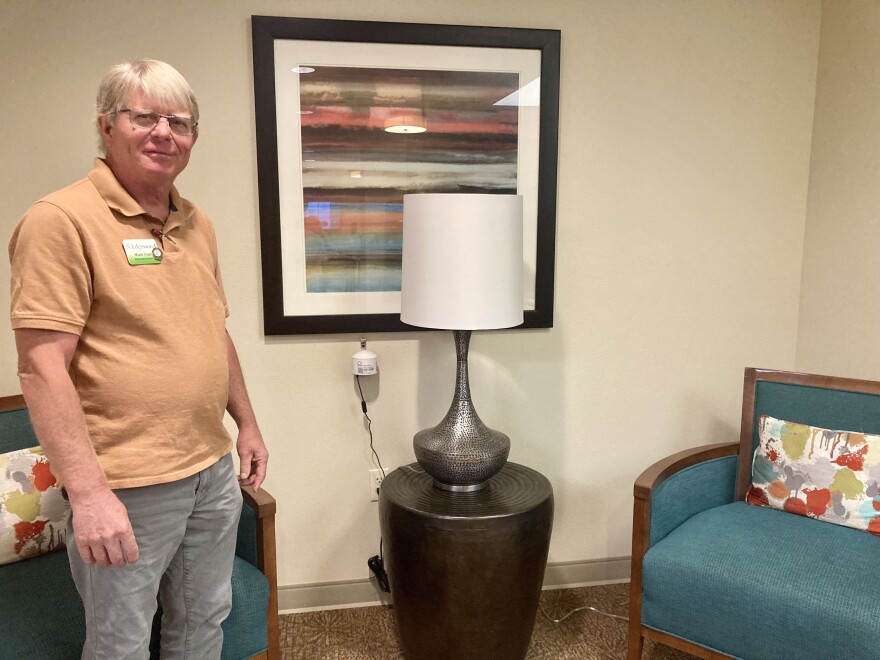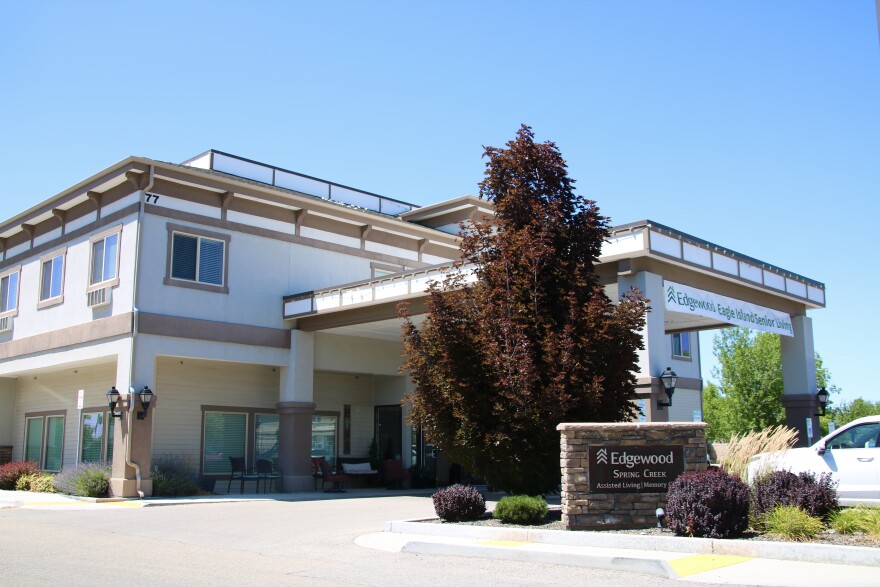Neil Rasmussen knows an all-too-familiar Idaho summer scene.
“It's hazy; you can't see the mountains,” he said.
He’s lived here for over a decade and says he’s noticed bigger wildfires over the past few years. That means more smoke, too.
This year, Rasmussen and his wife moved to Edgewood Spring Creek, an assisted living center in Eagle. A grandfather clock ticks in corner of his tidy room. At 82, he's acutely aware of how the smoke affects his health.
“I've noticed when I go out in that that my breathing — it hampers that to where I can't breathe as well as I need to,” he said from his reclining armchair.
On smoky days, he and his wife, who uses a wheelchair, skip their usual outings to nearby stores and the school next door, opting for strolls along the facility's hallways instead.
People like Rasmussen are why Edgewood jumped at the chance to be part of a research study to see how fires are affecting air quality for residents.
When there's smoke outside, how much is coming in?
Luke Montrose is leading the project. He’s an environmental toxicologist, and used to be based at Boise State University; now he’s an assistant professor at Colorado State University. Montrose recognized that those over 65 are at greater risk from wildfire smoke due to pre-existing heart and lung conditions.
But he wanted to know, when there’s smoke outside senior facilities, how much is coming in? How much swirls where residents dine and relax?
He began recruiting nursing homes and assisted living facilities to install air quality monitors, and started with four buildings in the summer of 2020.
Montrose said the suggestion that smoke could be affecting indoor air raised some eyebrows among some nursing home managers.
“There was some skepticism,” he said.

Public health messaging has mostly signaled to go inside when it’s smoky out, but Montrose was telling the facilities that it was more complicated. Inside might not be so safe.
“We have a barrier to cross now,” he acknowledged, “because our public health messaging didn't provide enough information for folks to be aware of that.”
Indoor air quality is largely not regulated. It's not as closely monitored or studied as outdoor air, even though most Americans spend about 90% of their time indoors.
“We owe it to ourselves to really consider what we could do to improve that air quality,” Montrose said.
He figured the best way to convince his participants was to show them the data.
Revealing the indoor air quality data
Mark Troen is in charge of building maintenance for the ten Edgewood Healthcare facilities in Idaho.
“This tells me what the indoor air quality is, real time,” he said, pointing to the indoor air monitor from Montrose hanging on the wall beneath a picture frame in the Eagle building's living room.

The data it collected the first summer showed Troen that when there was a wildfire outside, particulates would spike inside too.
According to the study Montrose's team published in the journal Indoor Air, the results from the first four facilities varied from building to building.
For Troen, the data drove home the point that, while he may not be a nurse or caregiver, his job is pivotal to residents' health.
“Nurses will do what they can inside the building,” he said, “but I need to make sure that the building envelope is secure to keep those particulates out.”
Troen spent decades working in dairy processing plants, starting with making ice cream and ending up managing equipment safety. But when he transitioned to senior living, it felt like a calling. He cherished hearing the stories of older adults' military experiences and world travels.
“Our elderly population doesn't get the respect they deserve,” Troen said. “You look at some countries like Japan that highly regard their elders, and I'd like to see more of that in America.”
So, it’s Edgewood residents like Rasmussen who are on his mind as he secures the building from wildfire smoke.
Guarding the building against smoke
On a July afternoon, in the back of a supply closet, Troen shimmied up a ladder and climbed through a latch to the roof.
He opened up a compartment on the rectangular HVAC system.
“This is the air coming out of the building; this is the air going in here,” he shouted over the noise of the machinery.
Troen explained what he does differently since joining the study. He switches to stronger filters — MERV 13s instead of MERV 8s — to catch more smoke particles. He also closes the fresh air intake vents, so they're not pulling in as much outdoor air.
Sarah Toevs, who directs the Center for the Study of Aging at Boise State, is another author on the Indoor Air study. She said the steps Edgewood and the other facilities are taking to protect residents from smoke inside are out of the norm.
“I think it’s pretty rare," she said. "I do not see this as something facilities across the country are doing, even in settings where they have some pretty dramatic fire events.”

A new data dashboard Montrose began rolling out this summer could help the facilities know when to spring into action.
On a recent morning, a grass fire flared up near the Eagle facility. If it had spread, and the sensors had begun picking up the particulate matter, Troen would've been on the roof, where everything is painted a blinding white, making these changes. But the fire was contained within the day.
Still, he wanted to make sure the facility was prepared for next time.
Back inside, facility workers gathered in a conference room for an all-staff meeting. They shared updates about an upcoming potluck. When it was Troen's turn, he shifted the conversation to air quality.
“If it starts getting to where it's even a moderate air quality issue outside,” he said, “we have certain steps we want to take to keep that outdoor air from coming into the building.”
Then, he quizzed them on the protocols.
“What are some of the steps we take?” he asked.
“Close the windows?” an employee chimed in. “Close the windows,” he echoed. “Doors are okay?” he asked, rhetorically. “Keep ‘em shut,” they said in unison.
Troen also told the staff to make sure the residents’ air conditioning units were set to recirculate the air instead of bringing it in from outside.
Now, nurses at the center also monitor the air quality data to make sure they have the necessary medications and to encourage residents with health concerns to stay indoors.
Four Edgewood facilities have indoor and outdoor air monitors as part of the research project. Troen would like them for all ten. He thinks every senior living center should have them. If you can do something to keep smoke out, why not, he said.
The reporting in this story was made possible, in part, by a grant from the Institute for Journalism and Natural Resources.
Find reporter Rachel Cohen on Twitter @racheld_cohen
Copyright 2023 Boise State Public Radio



